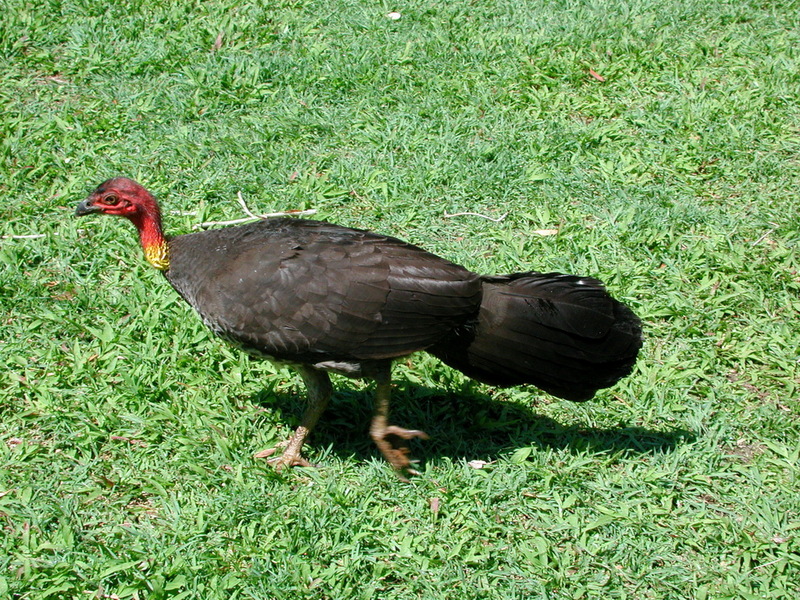Australian Brush-turkey (Alectura lathami) - Wiki Australian Brush-turkey
From Wikipedia, the free encyclopedia
Order: Galliformes
Family: Megapodiidae
[Photo] Australian Brush-turkey (Alectura lathami), Buschhuhn, Brisbane, Australia. Date 2002-09-25. Author Fritz Geller-Grimm.
The Australian brush-turkey Alectura lathami, also frequently called the Scrub Turkey, is a common, widespread species of mound-building bird from the family Megapodiidae found in eastern Australia from Far North Queensland to Illawarra in New South Wales. It is the largest of the three Megapodiidae that occur in Australia. Despite its name, the bird is not closely related to the American turkeys.
It is a spectacular large bird with a prominent, fan-like tail flattened sideways. The Brush-turkey is mainly black but has a bare red head, and a yellow or bluish-grey wattle. Their undersides are sprinkled with white feathers, more pronounced in older birds. The Brush-turkey flies very clumsily with heavy flapping when it is frightened and roosts in trees at night and during the heat of the day.
The adult Brush-turkey is 60-75 cm in length, with predominantly black body plumage, with a wingspan of about 85 cm. It has a featherless red head and a yellow throat wattle. The male's wattle becomes much larger during breeding season, often swinging from side to side as they run. The males' red heads and yellow wattles also become much brighter during the breeding and nesting season.
A smaller race, purpureicollis, lives in northern Cape York Peninsula. It has bluish-white wattles.
Brush-turkeys are communal birds, and have communal nests. A typical group consists of a dominant male, one or more younger males and several females. They build large nests on the ground made of leaves, other combustible material and earth, 1 to 1.5 metres high and up to 4 metres across. The eggs are hatched by the heat of the composting mound which is tended only by the males who regulate the temperature by adding or removing material to keep a constant temperature of 33-35°C. As with some reptiles, incubation temperature affects the sex ratio of chicks, which is equal at 34° C but results in more males when cooler and more females when warmer (p=0.035). It is unclear whether the parents use this to manipulate the sex of their offspring by, for instance, selecting the nesting site accordingly. Warmer incubation also results in heavier, fitter chicks (p<<0.0001), but how this is linked to gender is also unknown..
The same nesting site is frequently used year after year, the old ones being added to each breeding season. The average clutch of eggs is between 16 and 24 large white eggs, which are laid September to March. Sometimes up to 50 eggs laid by several females may be found in a single mound. The eggs are placed in a circle roughly 60-80 cm down, 20-30 cm apart, always with the large end up. The newly hatched young dig themselves out of the mound and then have to look after themselves.
Brush-turkey eggs are a favourite food of goannas, snakes, dingoes and dogs and once were a staple of Aboriginal Australians. Often goannas exhibit wounds on their tails of having been pecked by Brush-turkeys who ferociously chase them away from their nests.
In situations where they come into contact with humans, such as picnic areas in national parks, brush-turkeys exhibit little fear and will often boldly attempt to steal food from tables. They will nest in suburban gardens, and in search of material for their nests will patiently remove enormous amounts of mulch from neighbouring gardens.
http://en.wikipedia.org/wiki/Australian_Brush-turkey
| The text in this page is based on the copyrighted Wikipedia article shown in above URL. It is used under the GNU Free Documentation License. You may redistribute it, verbatim or modified, providing that you comply with the terms of the GFDL. |
